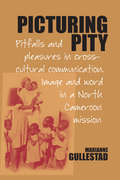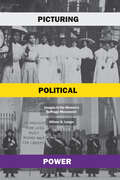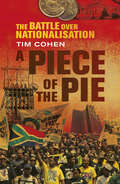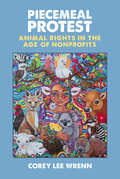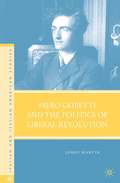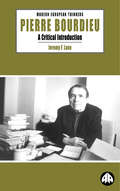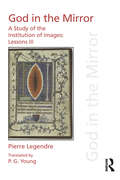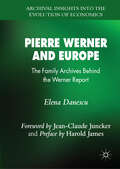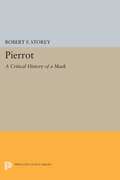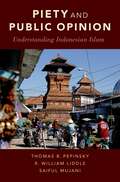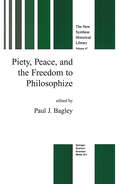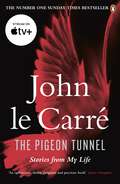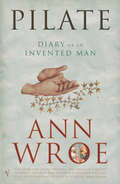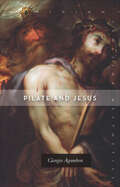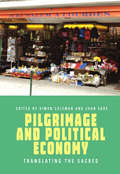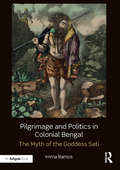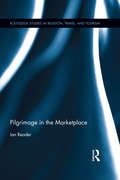- Table View
- List View
Picturing Pity: Pitfalls and Pleasures in Cross-Cultural Communication.<BR>Image and Word in a North Cameroon Mission
by Marianne GullestadPicturing Pity is the first full length monograph on missionary photography. Empirically, it is based on an in-depth analysis of the published photographs taken by Norwegian evangelical missionaries in Northern Cameroon from the early nineteen twenties, at the beginning of their activities in this region, and until today. Being part of a large international movement, Norway sent out more missionaries per capita than any other country in Europe. Marianne Gullestad's main contention is that the need to continuously justify their activities to donors in Europe has led to the creation and maintenance of specific ways of portraying Africans. The missionary visual rhetoric is both based on earlier visualizations and has over time established its own conventions which can now also be traced within secular fields of activity such as international development agencies, foreign policy, human relief organizations and the mass media. Picturing Pity takes part in the present "pictorial turn" in academic teaching and research, constituting visual images as an exciting site of conversation across disciplinary lines.
Picturing Political Power: Images in the Women’s Suffrage Movement
by Allison K. LangeLange's examination of the fights that led to the ratification of the Nineteenth Amendment in 1920 reveals the power of images to change history. For as long as women have battled for equitable political representation in America, those battles have been defined by images—whether illustrations, engravings, photographs, or colorful chromolithograph posters. Some of these pictures have been flattering, many have been condescending, and others downright incendiary. They have drawn upon prevailing cultural ideas of women’s perceived roles and abilities and often have been circulated with pointedly political objectives. Picturing Political Power offers perhaps the most comprehensive analysis yet of the connection between images, gender, and power. In this examination of the fights that led to the ratification of the Nineteenth Amendment in 1920, Allison K. Lange explores how suffragists pioneered one of the first extensive visual campaigns in modern American history. She shows how pictures, from early engravings and photographs to colorful posters, proved central to suffragists’ efforts to change expectations for women, fighting back against the accepted norms of their times. In seeking to transform notions of womanhood and win the right to vote, white suffragists emphasized the compatibility of voting and motherhood, while Sojourner Truth and other leading suffragists of color employed pictures to secure respect and authority. Picturing Political Power demonstrates the centrality of visual politics to American women’s campaigns throughout the nineteenth and early twentieth centuries, revealing the power of images to change history.
A Piece of the Pie: The Battle over Nationalisation
by Tim CohenNationalisation: Swear word for some, cure-all for others both within and outside the ruling party.Tim Cohen, a senior journalist with many years experience in both political and business reporting, traces the emergence of calls for nationalisation in South African politics. It is a subject which has become the most fiercely argued and passionate economic debate of modern-day South African politics. This is particularly so since the call for nationalisation is so closely associated with the emergence of the controversial Julius Malema, although the policy also has strong support from within the trade union movement. A Piece of the Pie offers a short, accessible overview of the political and economic debate surrounding nationalisation that emerged within the African National Congress after the 2010 general election. It traces the history of nationalisation and privatisation both locally and internationally and discusses the economic and political arguments that have made it such a topical and contentious issue in local politics. This book is an attempt to understand nationalisation more completely in order to enrich the ongoing debate.
Piecemeal Protest: Animal Rights in the Age of Nonprofits
by Corey Lee WrennGiven their tendency to splinter over tactics and goals, social movements are rarely unified. Following the modern Western animal rights movement over thirty years, Corey Lee Wrenn applies the sociological theory of Bourdieu, Goffman, Weber, and contemporary social movement researchers to examine structural conditions in the animal rights movement, facilitating factionalism in today’s era of professionalized advocacy. Modern social movements are dominated by bureaucratically oriented nonprofits, a special arrangement that creates tension between activists and movement elites who compete for success in a corporate political arena. Piecemeal Protest examines the impact of nonprofitization on factionalism and a movement’s ability to mobilize, resonate, and succeed. Wrenn’s exhaustive analysis of archival movement literature and exclusive interviews with movement leaders illustrate how entities with greater symbolic capital are positioned to monopolize claims-making, disempower competitors, and replicate hegemonic power, eroding democratic access to dialogue and decision-making essential for movement health. Piecemeal Protest examines social movement behavior shaped by capitalist ideologies and state interests. As power concentrates to the disadvantage of marginalized factions in the modern social movement arena, Piecemeal Protest shines light on processes of factionalism and considers how, in the age of nonprofits, intra-movement inequality could stifle social progress.
Piecing Together the Peaces: The Agricultural-Industrial Transition and the Rise of Zones of Peace
by William R. Thompson Alexander K. AntonyMany debates in interstate conflict and peace research address an important yet complex question: how, and to what degree, are the behavior of states and their relationships among one another fundamentally changing? The period after 1945 has seen a significant decline in the degree and intensity of warfare among states. While civil wars remain common, numerous scholars argue that a "long peace" has taken hold in which militarized interstate violence has become less common. Some argue that war has become obsolete as cultural attitudes toward war have changed, while others emphasize cognitive shifts that have reduced overall levels of human violence. Others favor material factors that have altered the historical net benefit of warfare among states. In Piecing Together the Peaces, Alexander K. Antony and William R. Thompson provide a novel explanation for how peace took hold in the international system and why state behavior drastically changed. According to the standard line of reasoning, states need only democratize, liberalize their trade, modernize their economic culture, or choose to forego territorial pursuits to reach peace with another state. As Antony and Thompson argue, most, if not all, of the processes put forward as causes of modern peace are highly intertwined with the macro-process of industrialization. Marshaling a long-view perspective, they show how the introduction of mechanization into production significantly altered nearly all aspects of economic and social life, including the costs and benefits of warfare. Rather than outlining a universal pathway through which states can arrive at peace, Antony and Thompson make the case that industrialization provides the starting point from which we can begin to unpack the transformation in conflict propensities among certain states. A bold challenge to the conventional wisdom that dominates interstate peace research, Piecing Together the Peaces shows that industrialization serves as the foundation for all other factors and processes fueling interstate peace.
Piecing Together the Peaces: The Agricultural-Industrial Transition and the Rise of Zones of Peace
by William R. Thompson Alexander K. AntonyMany debates in interstate conflict and peace research address an important yet complex question: how, and to what degree, are the behavior of states and their relationships among one another fundamentally changing? The period after 1945 has seen a significant decline in the degree and intensity of warfare among states. While civil wars remain common, numerous scholars argue that a "long peace" has taken hold in which militarized interstate violence has become less common. Some argue that war has become obsolete as cultural attitudes toward war have changed, while others emphasize cognitive shifts that have reduced overall levels of human violence. Others favor material factors that have altered the historical net benefit of warfare among states. In Piecing Together the Peaces, Alexander K. Antony and William R. Thompson provide a novel explanation for how peace took hold in the international system and why state behavior drastically changed. According to the standard line of reasoning, states need only democratize, liberalize their trade, modernize their economic culture, or choose to forego territorial pursuits to reach peace with another state. As Antony and Thompson argue, most, if not all, of the processes put forward as causes of modern peace are highly intertwined with the macro-process of industrialization. Marshaling a long-view perspective, they show how the introduction of mechanization into production significantly altered nearly all aspects of economic and social life, including the costs and benefits of warfare. Rather than outlining a universal pathway through which states can arrive at peace, Antony and Thompson make the case that industrialization provides the starting point from which we can begin to unpack the transformation in conflict propensities among certain states. A bold challenge to the conventional wisdom that dominates interstate peace research, Piecing Together the Peaces shows that industrialization serves as the foundation for all other factors and processes fueling interstate peace.
Piero Gobetti and the Politics of Liberal Revolution (Italian and Italian American Studies)
by J. MartinPiero Gobetti was a radical liberal and critic of Italian politics in the years after World War I, he proposed 'revolutionary liberalism', which guided his opposition to Fascism and inspired key figures in the Italian Resistance. Accessible but critical, this volume is offers a balanced assessment of his enduring significance.
Pierre Bourdieu: A Critical Introduction (Modern European Thinkers)
by Jeremy F. Lane'This beautifully written and lucidly argued study is the most persuasive account of Bourdieu's work yet to be published. Lane illuminates much that can puzzle a foreign readership by expertly situating Bourdieu within a French context. At the same time he points to those aspects of Bourdieu's writing which are of particular relevance to contemporary debates on questions of citizenship and globalisation. He gives a fascinating account of Bourdieu's astonishingly prescient analyses of the impact of the expansion of higher education, the influence of the mass media, the growth of the culture industries, and the changing nature of political and social elites, not just in France, but in the western world.' - Professor Jill Forbes, Queen Mary and Westfield, University of London
Pierre Legendre Lessons III God in the Mirror: A Study of the Institution of Images
by Pierre LegendreIn the context of our increasingly global legal order, Pierre Legendre’s God in the Mirror reconsiders the place of law within the division of existing bodies of knowledge. Navigating the texts of Ovid, Augustine, Roman jurists, medieval canon lawyers, Freud, Lacan, the notebooks of Leonardo de Vinci, and the paintings of Magritte, this third volume of Pierre Legendre’s Lessons focuses on the relation of the subject to the institution of images. Legendre tracks the origins and vicissitudes of the specular metaphor within western history, carrying out a critique of its dependence on the discourse of the Imago Dei. A crucial landmark within Legendre’s ongoing reconsideration of a medieval ‘revolution of interpretation’, this book dissociates the western normative tradition from its mythic foundation, separating theology and law. It thereby documents the advent of modern rational doubt, as a new legal foundation or ground: one that, for Legendre, was not only a revolutionary invention, but one that produced the modern European idea of the State.
Pierre Legendre Lessons III God in the Mirror: A Study of the Institution of Images
by Pierre LegendreIn the context of our increasingly global legal order, Pierre Legendre’s God in the Mirror reconsiders the place of law within the division of existing bodies of knowledge. Navigating the texts of Ovid, Augustine, Roman jurists, medieval canon lawyers, Freud, Lacan, the notebooks of Leonardo de Vinci, and the paintings of Magritte, this third volume of Pierre Legendre’s Lessons focuses on the relation of the subject to the institution of images. Legendre tracks the origins and vicissitudes of the specular metaphor within western history, carrying out a critique of its dependence on the discourse of the Imago Dei. A crucial landmark within Legendre’s ongoing reconsideration of a medieval ‘revolution of interpretation’, this book dissociates the western normative tradition from its mythic foundation, separating theology and law. It thereby documents the advent of modern rational doubt, as a new legal foundation or ground: one that, for Legendre, was not only a revolutionary invention, but one that produced the modern European idea of the State.
Pierre Werner and Europe: The Family Archives Behind the Werner Report (Archival Insights into the Evolution of Economics)
by Elena DanescuThis book- which features a foreword by Jean-Claude Juncker and Preface by Professor Harold James- examines the European vocation and achievements of Pierre Werner (1913–2002), former Prime Minister, Finance Minister and Foreign Minister of Luxembourg, unanimously recognized as one of the architects of Economic and Monetary Union. The author makes extensive use of Pierre Werner’s previously unpublished archives belonging to the Werner family, opened for the first time for research purposes. The book analyses the Werner Report, negotiations within the Werner Committee, the emergence of the Committee’s views on EMU, their political commitment to a European currency, the similarities and differences between their ideas, their personal networks, the influence of the states they represented, their theoretical and methodological input and their contribution to the political consensus.Chapters shed new light on various aspects of the European integration process and also on the role of Luxembourg and its European policy. In addition, the author has carried out a series of original interviews with Luxembourg and European figures who share their memories and thoughts concerning Pierre Werner, his achievements and his views on the European integration process, and also other topics such as Economic and Monetary Union and Luxembourg‘s European policy. This book will be of interest and value to researchers, EU policy makers and students in the fields of political economy, political science, economic history and history of economic thought.
Pierrot: A Critical History of a Mask
by Robert F. StoreyRobert Storey's lively and gracefully written study of Pierrot is the first scholarly history of this fascinating popular figure. Unlike previous studies of commedia dell'arte characters; this book focuses as much on Pierrot as a literary metaphor and mask as on the roles and dimensions of his stage character.Originally published in 1978.The Princeton Legacy Library uses the latest print-on-demand technology to again make available previously out-of-print books from the distinguished backlist of Princeton University Press. These editions preserve the original texts of these important books while presenting them in durable paperback and hardcover editions. The goal of the Princeton Legacy Library is to vastly increase access to the rich scholarly heritage found in the thousands of books published by Princeton University Press since its founding in 1905.
Piety and Public Opinion: Understanding Indonesian Islam
by Thomas B. Pepinsky R. William Liddle Saiful MujaniAcross the Muslim world, religion plays an increasingly prominent role in both the private and public lives of over a billion people. Observers of these changes struggle to understand the consequences of an Islamic resurgence in a democratizing world. Will democratic political participation by an increasingly religious population lead to victories by Islamists at the ballot box? Will more conspicuously pious Muslims participate in politics and markets in a fundamentally different way than they had previously? Will a renewed attention to Islam lead Muslim democracies to reevaluate their place in the global community of states, turning away from alignments with the West or the Global South and towards an Islamic civilizational identity? The answers to all of these questions depend, at least in part, on what ordinary Muslims think and do. In order to provide these answers, the authors of this book look to Indonesia--the world's largest Muslim country and one of the world's only consolidated Muslim democracies. They draw on original public opinion data to explore how religiosity and religious belief translate into political and economic behavior at the individual level. Across various issue areas--support for democracy or Islamic law, partisan politics, Islamic finance, views about foreign engagement--they find no evidence that the religious orientations of Indonesian Muslims have any systematic relationships with their political preferences or economic behavior. The broad conclusion is that scholars of Islam, in Indonesia and elsewhere, must understand religious life and individual piety as part of a larger and more complex set of social transformations. These transformations include modernization, economic development, and globalization, each of which has occurred in parallel with Islamic revivalism throughout the world. Against the common assumption that piety would naturally inhibit any tendencies towards modernity, democracy, or cosmopolitanism, Piety and Public Opinion reveals the complex and subtle links between religion and political beliefs in a critically important Muslim democracy.
Piety and Public Opinion: Understanding Indonesian Islam
by Thomas B. Pepinsky Saiful Mujani R. William LiddleAcross the Muslim world, religion plays an increasingly prominent role in both the private and public lives of over a billion people. Observers of these changes struggle to understand the consequences of an Islamic resurgence in a democratizing world. Will democratic political participation by an increasingly religious population lead to victories by Islamists at the ballot box? Will more conspicuously pious Muslims participate in politics and markets in a fundamentally different way than they had previously? Will a renewed attention to Islam lead Muslim democracies to reevaluate their place in the global community of states, turning away from alignments with the West or the Global South and towards an Islamic civilizational identity? The answers to all of these questions depend, at least in part, on what ordinary Muslims think and do. In order to provide these answers, the authors of this book look to Indonesia--the world's largest Muslim country and one of the world's only consolidated Muslim democracies. They draw on original public opinion data to explore how religiosity and religious belief translate into political and economic behavior at the individual level. Across various issue areas--support for democracy or Islamic law, partisan politics, Islamic finance, views about foreign engagement--they find no evidence that the religious orientations of Indonesian Muslims have any systematic relationships with their political preferences or economic behavior. The broad conclusion is that scholars of Islam, in Indonesia and elsewhere, must understand religious life and individual piety as part of a larger and more complex set of social transformations. These transformations include modernization, economic development, and globalization, each of which has occurred in parallel with Islamic revivalism throughout the world. Against the common assumption that piety would naturally inhibit any tendencies towards modernity, democracy, or cosmopolitanism, Piety and Public Opinion reveals the complex and subtle links between religion and political beliefs in a critically important Muslim democracy.
Piety, Peace, and the Freedom to Philosophize (The New Synthese Historical Library #47)
by Paul J. BagleyThe 11 essays collected here have been composed by members of the North American Spinoza Society. They exhibit the fruits of the research, investigation and erudition of an array of established scholars and newer students whose interpretations of Spinoza's philosophical doctrines are receiving critical acclaim. This is the first collection in the English language dedicated exclusively to topics, problems or questions raised by the teachings found in Baruch Spinoza's Tractatus theologico-politicus. Divided into the themes of piety, peace, and the freedom to philosophize, the essays treat Spinoza's views on faith and philosophy, miracles, the light of Scripture, political power, religion, the state, the body politic, the idea of tolerance, and philosophic communication, as well as his connections to Walter Benjamin, Blaise Pascal, David Hume, and his Jewish heritage. Readership: An excellent collection for students and scholars studying Spinoza, the history of early modern philosophy, political philosophy, philosophy of religion, and those concerned with theologico-political questions.
The Pigeon Tunnel: Stories from My Life
by John le CarréTHE SUNDAY TIMES NUMBER ONE BESTSELLING MEMOIR OF SPY-WRITING LEGEND JOHN LE CARRÉ'As recognizable a writer as Dickens or Austen' Financial TimesFrom his years serving in British Intelligence during the Cold War to a career as a writer, John le Carré has lived a unique life.In this, his first memoir, le Carré is as funny as he is incisive - reading into the events he witnesses the same moral ambiguity with which he imbues his novels. Whether he's interviewing a German terrorist in her desert prison or watching Alec Guinness preparing for his role as George Smiley, this book invites us to think anew about events and people we believed we understood.Best of all, le Carré gives us a glimpse of a writer's journey over more than six decades, and his own hunt for the human spark that has given so much life and heart to his fictional characters.'No other writer has charted - pitilessly for politicians but thrillingly for readers - the public and secret histories of his times' Guardian'When I was under house arrest I was helped by the books of John le Carré . . . These were the journeys that made me feel that I was not really cut off from the rest of humankind' Aung San Suu Kyi
Pilate: The Biography Of An Invented Man
by Ann WroeAlthough very little is known for certain about Pontius Pilate, the man who crucified Christ, this has not stopped writers in every age from imagining his life. In this extraordinary book, Ann Wroe recounts the lives of all our Pilates; among them the glittering medieval tyrant, devoted to gambling and getting around the law, and the wriggling modern pragmatist, whose dilemma over Jesus has been described by Tony Blair as 'a timeless parable of political life'. This is also the story of the man Pilate might have been; and the man who mirrors us. Ann Wroe shows how, in his struggles with fate and free will, Pilate's story has also become the story of ourselves.
Pilate and Jesus (Meridian: Crossing Aesthetics)
by Giorgio AgambenPontius Pilate is one of the most enigmatic figures in Christian theology. The only non-Christian to be named in the Nicene Creed, he is presented as a cruel colonial overseer in secular accounts, as a conflicted judge convinced of Jesus's innocence in the Gospels, and as either a pious Christian or a virtual demon in later Christian writings. This book takes Pilate's role in the trial of Jesus as a starting point for investigating the function of legal judgment in Western society and the ways that such judgment requires us to adjudicate the competing claims of the eternal and the historical. Coming just as Agamben is bringing his decades-long Homo Sacer project to an end, Pilate and Jesus sheds considerable light on what is at stake in that series as a whole. At the same time, it stands on its own, perhaps more than any of the author's recent works. It thus serves as a perfect starting place for readers who are curious about Agamben's approach but do not know where to begin.
Pilgrim Spy: My secret war against Putin, the KGB and the Stasi
by Tom ShoreThis is one of the great untold stories of the twentieth century.It is a first-hand account of a mission by an SAS soldier sent behind the Iron Curtain by MI6 to find someone who didn't necessarily want to be found and how, on a follow-up mission, he found himself manoeuvring against a mysterious KGB officer - one Major Vladimir Putin and a murder plot by Kremlin hardliners. If the plot had succeeded, it would have given the Russians the excuse they were looking for to roll out the tanks across East Germany, the Berlin Wall would not have fallen - and the map of Europe would look very different today.It tells of roof top chases, the interrogation of terrorists to gain vital information, a beautiful, East German female (who he suspected of being a Stasi spy), betrayal by people he trusted, an escape through forests pursued by enemy agents and ending in a climactic gun battle at Colditz castle, formerly used by the Soviets as a psychiatric hospital to detain dissidents.In James Bond novels, it is MI6 operators who carry out this type of work, but in reality, when facing a committed foe in an isolated and deadly environment, the intelligence agencies call upon members of the British Special Forces. This is the first insider account of how UK operators working undercover, do what needs to be done in order to protect the UK's interests abroad - revealing their hidden hand in world events.
Pilgrimage and Political Economy: Translating the Sacred
by Simon Coleman and John EadePilgrimage has always had a tendency to follow—and sometimes create—trade routes. This volume explores how wider factors behind transnational and global mobility have impacted on pilgrimage activity across the world, and examines the ways in which pilgrimage relates to migration, diaspora, and political cooperation or conflict across nation-states. Furthermore, it brings together case studies that explore forms of mobility where pilgrimage is juxtaposed, complements, or is in intimate association with other forms of movement.
Pilgrimage and Politics in Colonial Bengal: The Myth of the Goddess Sati
by Imma RamosFrom the late nineteenth century onwards the concept of Mother India assumed political significance in colonial Bengal. Reacting against British rule, Bengali writers and artists gendered the nation in literature and visual culture in order to inspire patriotism amongst the indigenous population. This book will examine the process by which the Hindu goddess Sati rose to sudden prominence as a personification of the subcontinent and an icon of heroic self-sacrifice. According to a myth of cosmic dismemberment, Sati’s body parts were scattered across South Asia and enshrined as Shakti Pithas, or Seats of Power. These sacred sites were re-imagined as the fragmented body of the motherland in crisis that could provide the basis for an emergent territorial consciousness. The most potent sites were located in eastern India, Kalighat and Tarapith in Bengal, and Kamakhya in Assam. By examining Bengali and colonial responses to these temples and the ritual traditions associated with them, including Tantra and image worship, this book will provide the first comprehensive study of this ancient network of pilgrimage sites in an art historical and political context.
Pilgrimage and Politics in Colonial Bengal: The Myth of the Goddess Sati
by Imma RamosFrom the late nineteenth century onwards the concept of Mother India assumed political significance in colonial Bengal. Reacting against British rule, Bengali writers and artists gendered the nation in literature and visual culture in order to inspire patriotism amongst the indigenous population. This book will examine the process by which the Hindu goddess Sati rose to sudden prominence as a personification of the subcontinent and an icon of heroic self-sacrifice. According to a myth of cosmic dismemberment, Sati’s body parts were scattered across South Asia and enshrined as Shakti Pithas, or Seats of Power. These sacred sites were re-imagined as the fragmented body of the motherland in crisis that could provide the basis for an emergent territorial consciousness. The most potent sites were located in eastern India, Kalighat and Tarapith in Bengal, and Kamakhya in Assam. By examining Bengali and colonial responses to these temples and the ritual traditions associated with them, including Tantra and image worship, this book will provide the first comprehensive study of this ancient network of pilgrimage sites in an art historical and political context.
Pilgrimage in the Marketplace (Routledge Studies in Pilgrimage, Religious Travel and Tourism)
by Ian ReaderThe study of pilgrimage often centres itself around miracles and spontaneous populist activities. While some of these activities and stories may play an important role in the emergence of potential pilgrimage sites and in helping create wider interest in them, this book demonstrates that the dynamics of the marketplace, including marketing and promotional activities by priests and secular interest groups, create the very consumerist markets through which pilgrimages become established and successful – and through which the ‘sacred’ as a category can be sustained. By drawing on examples from several contexts, including Japan, India, China, Vietnam, Europe, and the Muslim world, author Ian Reader evaluates how pilgrimages may be invented, shaped, and promoted by various interest groups. In so doing he draws attention to the competitive nature of the pilgrimage market, revealing that there are rivalries, borrowed ideas, and alliances with commercial and civil agencies to promote pilgrimages. The importance of consumerism is demonstrated, both in terms of consumer goods/souvenirs and pilgrimage site selection, rather than the usual depictions of consumerism as tawdry disjunctions on the ‘sacred.’ As such this book reorients studies of pilgrimage by highlighting not just the pilgrims who so often dominate the literature, but also the various other interest groups and agencies without whom pilgrimage as a phenomenon would not exist.
Pilgrimage in the Marketplace (Routledge Studies in Pilgrimage, Religious Travel and Tourism)
by Ian ReaderThe study of pilgrimage often centres itself around miracles and spontaneous populist activities. While some of these activities and stories may play an important role in the emergence of potential pilgrimage sites and in helping create wider interest in them, this book demonstrates that the dynamics of the marketplace, including marketing and promotional activities by priests and secular interest groups, create the very consumerist markets through which pilgrimages become established and successful – and through which the ‘sacred’ as a category can be sustained. By drawing on examples from several contexts, including Japan, India, China, Vietnam, Europe, and the Muslim world, author Ian Reader evaluates how pilgrimages may be invented, shaped, and promoted by various interest groups. In so doing he draws attention to the competitive nature of the pilgrimage market, revealing that there are rivalries, borrowed ideas, and alliances with commercial and civil agencies to promote pilgrimages. The importance of consumerism is demonstrated, both in terms of consumer goods/souvenirs and pilgrimage site selection, rather than the usual depictions of consumerism as tawdry disjunctions on the ‘sacred.’ As such this book reorients studies of pilgrimage by highlighting not just the pilgrims who so often dominate the literature, but also the various other interest groups and agencies without whom pilgrimage as a phenomenon would not exist.
Pilgrimage, Politics, and International Relations: Religious Semantics for World Politics (Culture and Religion in International Relations)
by M. BarbatoA standout contribution to post-secular IR theory, this book addresses issues of global politics, from cooperation to conflict, and shows how a religious metaphor, the pilgrim, can help us to rethink our concepts of self, agency, and community in a time of changing world order.
